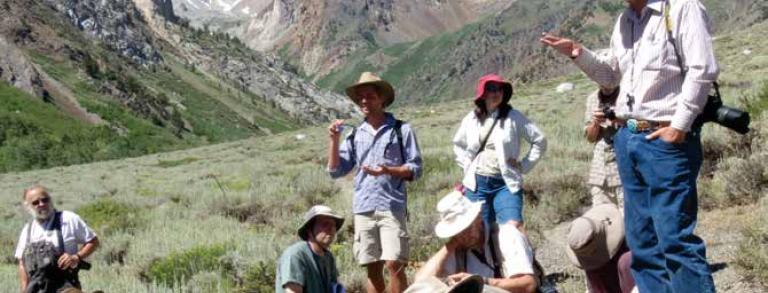It started quickly. Bob McFarlane and I had just formed the Eriogonum Society in 2009. We called Jim acknowledging that we knew he had a busy schedule, but would he consider being the “Godfather” of the fledgling society. There was not a bit of hesitation. He offered
his whole portfolio of images, the online key, and authored five extensive newsletter articles in quick succession which we posted on the Eriogonum Society website. We were on our way. Next we described to Jim how the organization operated, specifically focused on the annual meetings. Jim gave us a list of five sites he thought would be of worth. And so it was to be Reno for our inaugural meeting, based at the University of Nevada in Reno. Such was Jim’s operating procedure: full on.
Being a member of several plant-focused organizations, I had an idea of what plant societies looked like. I soon found that this one would be different. The first day of the annual meetings was dedicated to an extensive practicum, led by Jim, on Eriogonum identification, morphology, and taxonomy. The next couple of days we went to the field and practiced our new found skills. Jim was kind and patient but directed us to hone the skill of keen observation.
So often we would witness Jim’s zest for life and his passion for this favorite genus. Perhaps the finest teacher many of us had encountered, we looked forward each year to his “pollination dance” as we called it. His arms crossed upon his chest would unfurl in demonstration of the stamen unfurling and rising like some offering to the universe, a great smile upon his face as he explained the process, then the arms came down and folded again, then rise again, signifying the second day offering of the remaining stamen. It was truly a dervish dance that culminated with a gleam in Jim’s eyes.
Then he might spend the next session plying us with descriptions of the various degrees of hairiness from floccose to hirsute. There would be discussions of stipes and petioles and such. We would fly through the key he would supply each year, sometimes a thousand pages
in length. Each edition would have considerable changes from the previous years, testament to his continued examination of the genus.
It was the norm that he would appear at the meetings with large white bags of specimens he collected on his way to the venue. These specimens would be the stuff of practice; we would group in twos and threes and attempt the identification. Jim walked the room, guiding us through our attempts and showing us where we went wrong when we were hopelessly lost down some rabbit hole of a bad choice of identification. Jim was always the cheerleader, applauding our efforts.
Jim was equally at home in the field. We gathered around, lens in one hand, and specimen in the other, and listened in awe as the intricacies were explained in minute detail, not only of the structure, but also the theories of why such existed. Many times we sat around at lunch break, listening to stories about the adventures of those botanists who came before him and the herculean efforts they made to document the flora of young America. There was a realization that those days were passing quickly and that his generation were the last of the greats. The story
of Douglas and his stumbling through life and tragic end was one that mesmerized us at a McGee Creek picnic area as we sat in the presence of the Sierra Nevada range, visualizing days of yore. The man could spin a story. Jim penned a wonderful book, Gentle Conquest, The Botanical Discovery of North Americas with illustrations from the Library of Congress which is a must read for those interested in the early explorations. It received the Outstanding Academic Book Award from the Association of College and Research Libraries in 2009.
So it was that Jim’s format shaped the society. Another homage to Jim would be the number of professional members of various federal, state, and local agencies who became members and attended the meetings. The admiration and respect was infectious as we all clamored to hear pearls of wisdom as he spoke about changes in botany and the evolution of plant identification. Several of these organizations offered educational credits simply for attending the lectures.
Of course, one cannot overlook his eagerness to explore. In 2008, at a meeting of the Penstemon Society in Ely, Nevada, a few of us mentioned that we had seen a glorious hill on the way to Nevada from Colorado where at least four species of Eriogonum were to be found in close proximity to each other. This conversation was near the crest of Sacramento Pass outside of Great Basin National Park. Off we went, forty miles to the east, in caravan! Upon arrival we explored the area. Jim grabbed samples of each of the species, holding each aloft for us to see the diagnostic approach to keying the various species, and held forth with stories of the discovery of a few. There were stories on that trip of his explorations with his friend and fellow field companion, Noel Holmgren, as they explored much of the West.
Other than stories of Jim’s approachability, one must certainly raise a toast to one of the finest scholars in this and the previous century. He published over 530 titles of scientific papers and books. Dr. Reveal was also a recipient of the Edgar T. Wherry Award from NARGS in 2009. Jim was also a major contributor to the Intermountain Flora. More about Professor Reveal’s formidable academic achievements can be found at <www.nbh.psla.umd.edu/collection/reveal.html>.
We owe Jim a huge debt of gratitude for his many contributions and also to his willingness to speak at various chapters and NARGS functions.
Here’s to Jim Reveal, a combination of story teller, scholar, kind soul, teacher, and plantsman.

